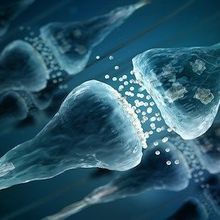vesicles

Exploring Extracellular Vesicles: Biomarkers and Beyond
Biotium | Jul 23, 2024 | 1 min read
Advances in molecular profiling tools and techniques help scientists detect and identify extracellular vesicle markers.

Cancer Cells Give Orders
Holly Barker, PhD | Apr 23, 2024 | 4 min read
Cancer-supporting cells control their neighbors’ behavior using an often-overlooked protein delivery system.

Engineered RNA Export From Living Cells
Danielle Gerhard, PhD | Dec 1, 2023 | 1 min read
A nondestructive approach for packaging, exporting, and delivering RNA provides a glimpse into the dynamic lives of cells.

Capturing Exosomes from Cell Culture Media
Thermo Fisher Scientific | Mar 13, 2023 | 1 min read
Scientists choose ultracentrifugation techniques for simplicity and proven efficacy in exosome purification.

Exosome Scientist Douglas Taylor Stole and Mislabeled Images: Report
Katherine Irving | Nov 23, 2022 | 2 min read
Taylor, formerly of the University of Louisville, is known for his discovery of and research on tumor-secreted exosomes.

Vesicles from Young Mice Alleviate Signs of Aging in Older Animals
Catherine Offord | Oct 19, 2022 | 4 min read
Mice that received the stem cell–derived treatment were less frail compared with controls, a study reports.

Extracellular Vesicles: Applications and Potential
Beckman Coulter Life Sciences | May 13, 2022 | 1 min read
Explore why extracellular vesicles are attractive candidates for new therapeutic approaches.

Fat Cells Send Mitochondrial Distress Signals to the Heart
Ruth Williams | Aug 20, 2021 | 3 min read
Vesicles containing fragments of the organelles released from stressed adipocytes protect the heart against oxygen deprivation, a study in mice shows.

PD-L1 in Extracellular Vesicles May Help Glioblastoma Evade Immunotherapies
Jim Daley | Mar 8, 2018 | 2 min read
The discovery suggests that the immune checkpoint can operate at a further distance from tumor cells than previously believed.

Neurons Use Virus-Like Proteins to Transmit Information
Diana Kwon | Jan 15, 2018 | 2 min read
In mice and flies, the Arc protein forms capsids and carries genetic information.

Macrophages Physically Relay Signals Between Cell Types
Catherine Offord | May 1, 2017 | 3 min read
Time-lapse imaging shows the immune cells transferring chemical signals during pigment pattern formation in developing zebrafish.

Infographic: How the Zebrafish Got Its Stripes
Catherine Offord | Apr 30, 2017 | 1 min read
Immune cells called macrophages shuttle cellular messages in the skin.

Neuron Signaling Persists, Faintly, Even When Key Presynaptic Proteins Are Absent
Ben Andrew Henry | Nov 1, 2016 | 2 min read
Results from experiments in mice revise a long-held hypothesis that certain protein scaffolds are needed for synaptic activity.

Palade Particles, 1955
Kerry Grens | Feb 1, 2014 | 2 min read
Electron microscopy led to the first identification of what would later be known as ribosomes.

Palade and His Particles
Kerry Grens | Jan 31, 2014 | 1 min read
Nobel Laureate Christian de Duve discusses the impact of George Palade’s work on ribosomes.

Microbes Expel Swarms of Vesicles
Kerry Grens | Jan 10, 2014 | 2 min read
Scientists present the first evidence that marine cyanobacteria release vesicles—billions and billions of vesicles.

Week in Review: October 7–11
Jef Akst | Oct 11, 2013 | 5 min read
Nobels awarded for vesicle trafficking and computational chemistry; building 3-D microbial communities; mislabeled microbes cause retractions

Vesicle Trafficking Trio Wins Nobel
Kerry Grens | Oct 7, 2013 | 2 min read
James Rothman, Randy Schekman, and Thomas Südhof share Nobel Prize in Medicine or Physiology.
SNAREs at the Synapse
Megan Scudellari | Jul 1, 2012 | 3 min read
Using tiny lipid discs, scientists resolve contradictory evidence about how many proteins are required for neurotransmitter release.
